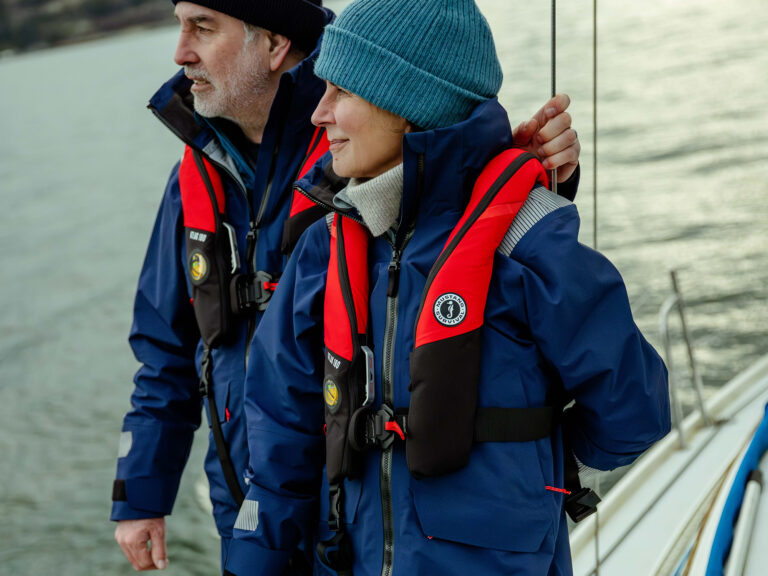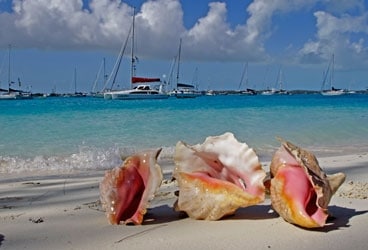
conch 368
Rockin’ Ron is ready. The tools for his job are close at hand. It’s 0745 on a blustery morning in the otherworldly harbor of George-Town, the glorious centerpiece around which life revolves on the striking island of Great Exuma, in the Bahamas. Assembled near Ron in the comfy center-cockpit of his Morgan 45, Sea Dancer, are these crucial items: a large cup of coffee; a pen and legal pad; a boom box; and, finally, the device that will play the central role in the upcoming enterprise, a VHF radio switched to “high.” Down below, the Rockin’ one’s better half, Karen, operates a second VHF.
At the stroke of 0800, Ron switches over to Channel 72, hits the boom box “on” switch, and presses the transmit button on his cockpit-mounted VHF. As music cascades across the vast anchorage via the dozens and dozens of boats tuned into the broadcast, Rockin’ Ron, with the polished delivery of a seasoned radio DJ, lets her rip:
“Good morning George-Town and cruisers! And what a night it was! This is Rockin’ Ron and Cool Karen aboard Sea Dancer, broadcasting to you live on WGTWN-VHF 72. Welcome to the 29th annual George-Town Cruising Regatta.
 Bob Grieser Bob Grieser |
| Rockin’ Ron with all his tools of the trade. |
“Today, it’s tennis at February Point, and later this afternoon, it’s the bridge tournament at St. Francis Resort. Let’s see how our day’s going to be weather-wise by switching to our weather guru, Electrifying Ernie, anchored somewhere north of Hamburger Beach. Ernie, come on and tell us what the weather’s gonna do!”
And thus, another hectic day begins.
For the next half an hour, Rockin’ Ron will choreograph a seamless, wide-ranging show packed with oodles of useful information and broken down into several dedicated segments: Business, Regatta, Community, and Boaters General. At sea and on land, listeners will be updated on topics ranging from today’s special at Eddie’s Edgewater (meatloaf) to tomorrow’s big awards ceremony (and the Rockin’ Ron Dance Party) at the beach bar (and unofficial regatta headquarters) called the Chat ‘n’ Chill. We’ll learn that John on Buddy needs crew for his trip to Puerto Rico, that Doug on Bad Boy is flying to the mainland and is happy to take any “flat, stamped mail,” and that Bob on Kavali House is offering “safe, secure, non-liveaboard boat storage” over in the anchorage known as Hole 3.
But my favorite bit comes from a fellow named Dan on Borrowed Horse. “Good morning. I’m your self-appointed spokesperson for A.R.G.,” he growls. “The Alcohol Research Group. We’re announcing an impromptu get-together today at 5 p.m. at Hamburger Beach. We’d like you to bring a dish to share, some research material, possibly a musical instrument, and your well-behaved pets and children. We look forward to seeing you there.”
When all is said and done, Rockin’ Ron wraps it up quickly: “I’m going to sign off here, switch to 6-8, and go back to low power. Have a great Exuma day. The net is clear.”
Like everyone else in this (and almost every other) cruising community, Ron and Karen Sobon aren’t known by their last names; they’re “Ron and Karen on Sea Dancer.” Having retired from their respective careers in New Jersey-he at Verizon, she in commercial real estate-they’ve been making an annual pilgrimage to George-Town for 10 years now. “That seems to be a good average for how long people last,” said Ron. “We’re there. We’re the oldies now.”
Though working the George-Town Cruisers Net, which is an ongoing, year-round affair, is supposed to be a week-long duty before it gets passed to another cruiser, Rockin’ Ron, because he’s so good at it, has been asked to take over for the duration of the Cruising Regatta. He’s happy to do so, as it fits in naturally with the prevailing vibe, which has brought him back year after year.
“It’s the camaraderie,” he said. “Everybody helps everybody. If someone’s dragging anchor or has some other issue, people are running over to help you out. There’s just such a good attitude. What we always say is that George-Town is the way the whole world should be.”
Rockin’ Ron is a cool cat, and I have other questions for him, but he has to run. The other day, he was on the four-person team that made it to the finals of the ridiculously competitive Regulation Volleyball Tournament-there’s also Fun Volleyball for mellower players-and today he’s off to compete in the tennis tournament.
The following bears mention, because along with the general George-Town attitude, another recurring theme among the cruisers is afoot. Like many of the folks I’ll meet at the event, Rockin’ Ron is trim and fit, vital and energetic, and could easily be mistaken for a 50-year-old. In reality, he’s 67.
It can’t be a coincidence. Somewhere in George-Town, along with such popular local waypoints as the towering Monument on Stocking Island and Mimm’s Market, there’s got to be a Fountain of Youth.
Once upon a time-before the variety shows, athletic competitions, ham-radio seminars, arts and crafts, sand-sculpture contests, pet parades, scavenger hunts, bridge and Trivial Pursuit tournaments, poker nights, and so forth-the George-Town Cruising Regatta was, well, a sailboat race. Given what transpires today, the whole extravaganza is almost impossible to fathom.
Mickey Walsh was there at the beginning. These days, he lives aboard in George-Town harbor with his wife, Joyce, on their Hardin 45, High Hopes. But for many years, he’d set out from Long Island, New York, each fall with his three daughters aboard the family’s 29-foot Garden-designed double-ender, Valkyrie, and wander through the Bahamas until it was time to sail home and get back to his seasonal occupation, grooming the beach at the Fire Island National Seashore.
Walsh says it was a wild group of Texas cruisers that used to sail in company who launched the inaugural edition of the event during the winter of 1979-1980. “We used to call them the Texas Navy,” he said. “They’d cruise down from the Abacos like a bunch of locusts. They were all kooks, but they were active and did a lot of things. They said, ‘Let’s have a race,’ and that’s basically what the first year was. Later on, a lot of other people got interested in it and said, ‘Oh, let’s do this and that.’
“I personally never got too involved,” he added, voicing a sentiment that many other visiting sailors have subscribed to over the years. “I kind of resented it a little bit. They organized everything! I came down here to get away from all that.”
An ex-pat American dentist known as Dr. Joel took the baton from the rambunctious Texans and, as Walsh recalled, “started making an enterprise out of it.” It was the entrepreneurial doctor who came up with the tradition, which holds to this day, of selling distinctive regatta T-shirts each year, the proceeds from which largely covered the costs of the event. Anything left over, then and now, is donated to the National Family Island Regatta-the colorful races conducted in local Bahamian sloops and dinghies each April-as well as to other local causes and charities. Over the years, tens of thousands of dollars have been so funneled into the local economy.
The one thing, Walsh said, that George-Town always had going for it was the incredible natural harbor: “I call it a Captains Resort. Think about it. It’s got the most beautiful anchorage you could ever imagine. If you cruise in the Bahamas at all, you know you have to anchor in the wind and current on a Bahamian moor, which is a pain in the ass. You don’t have that here. Any place in this harbor, you’ve got a beautiful anchorage and great holding. We’ve made a lot of friends here over the years. It’s like home. I see a lot of boats come through here on the way to Puerto Rico or the Caribbean, and the crews get in here and just say, ‘Why? Why leave?'”
Ultimately, Dr. Joel and the event parted ways in what’s been described as “difficult” financial circumstances. Today, the management of the regatta is in the hands of the cruisers themselves, with oversight provided by a local George-Town merchant, Mike Mimms, the proprietor of the busy downtown supermarket. A dedicated regatta chairman is responsible for the overall organization, while individual chairs oversee the respective seminars, contests, and shows. On average, each costs a mere US$2 to enter.
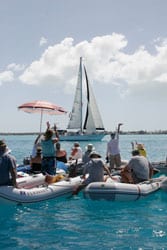
Bob Grieser| |Throngs of cruisers cheer the finishers of the Around Stocking Island Race. The In-Harbor Race (far right), run a few days later, is another spirited affair.|
In both 2008 and 2009, retired Canadian swim coaches Stuart and Marilyn on Union Jack, a Nauticat 33, shared the chief duties. “Two years ago, to our great surprise, the previous chairmen, from Tennessee, came by one day and asked if we’d like to take over for them,” said Stuart. “I said, ‘No.’ Marilyn said, ‘Yes.’
“So,” he laughed. “We took over for them. OK.”
The couple first ventured to George-Town in 1988, and Stuart, an avid bridge player, volunteered to teach the game for the simplest of reasons: He wanted partners so he could play on the beach. After retirement, in 2000, their visits became annual. Marilyn said that at the high point, a few years ago, as many as 500 boats visited the harbor for the regatta. In 2009, with the downturn in the economy, she fretted that they wouldn’t be able to recoup their investment, in both time and money: The event takes a full year to organize, has an annual budget of around US$20,000, and they’d just pre-ordered 800 T-shirts and hats.
“But we still had 350 boats at the max this year,” said Marilyn, “and every single item was sold.”
Stuart said their management philosophy, as regatta chairmen, was very straightforward. “Our goal was to make it as much fun as possible, to be nice to everybody, and to be as inclusive as we could be to the people who live here. No controversy. No exclusivity. We just wanted everyone to participate.”
In George-Town, as I’d soon discover, participation isn’t a problem.
With photographer Bob Grieser, I arrived in George-Town some nine days into the two-week regatta, so among the many early events I missed was the opening variety show, which everyone agreed had been a doozy. But I was just in time for the finals of the Regulation Beach Volleyball Tournament, which turned out to be an ideal place to jump in.
The tourney chairmen were Wayne and Isabel on Cassiopeia, a good ol’ 1966 Pearson Vanguard from Marquette, Michigan. Sweaty Wayne wasn’t only helping organize the event; he was also on a team wending its way through the round-robin. But he stopped for a breather between games. Recently retired from the art department at Northern Michigan University, he’d taken the plunge as both a sculptor and a sailor.
“I’m going to try and be a real artist instead of an educator,” he said. “Sailing will be a big part of it: The inspiration, the people you meet, it just gives you a different perspective. We’re on one of the smaller boats out here, but it’s the boat we had, and the boat we like. Plus, I’ve got a good woman. It’s tough to find a good woman to stick with you, especially on a small boat.”
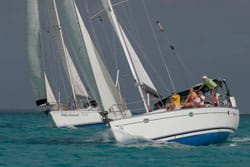
Bob Grieser| |The In-Harbor Race (far right), run a few days later, is another spirited affair.|
Over at the scoring table, the good woman in question, Isabel, was busy filling in the brackets and keeping the action moving. “It’s our second season coming down here,” she said. “We just loved it, so we volunteered to chair an event. Get involved. Do your part. That’s the way it is here in George-Town.”
The top teams were playing a skilled and spirited brand of volleyball, but after a while, it got a little tiring just watching them battle under the blazing sun. Over by the regatta bulletin board, under some shady casuarinas, I ran into Mark and Gwyn on Ala, a Leopard 40 hailing from Chesapeake Bay, as they scanned the scratch sheet for the next day’s race around Stocking Island. It would be their first sailboat race ever.
“We didn’t plan on being plopped in this place for so long,” said Gwyn, echoing yet another familiar and oft-repeated refrain. “We were warned if we got to George-Town and put the anchor down, it might be a while before we picked it up again.”
Over on a picnic bench, George and Toby on Puff, a neat little houseboat tucked up in the shallows, said they felt no desire to pull up stakes. Then again, Puff has no engines and is permanently moored. Like many other cruisers, the couple made a permanent move to George-Town after many years of regular visits aboard their Tartan 37 and, later, their Morgan 44.
“When we first started sailing to the Bahamas, all we heard about were the great crowds in George-Town, how there was no room,” said George. “So we ventured on down and found out none of it was true. There’s always room to anchor. It’s a big, huge, immense harbor. And it’s a lot warmer here than in the Abacos.”
George and Toby insisted that we meet some friends of theirs, French-Canadians Michel and Louise on Marie-Antoine, a 42-foot trawler. The Canadian presence is very strong in George-Town; in fact, it seems like every other boat in the anchorage sports the familiar red-and-white Maple Leaf flag snapping off the transom.
Like many of their countrymen, Michel and Louise commute back and forth to Canada every six months to meet the residency requirements to retain their health insurance. But Michel, a former executive at Xerox who left the company in 2000, reckons that the time he spends in the islands plays the largest role in his well-being.
“Those last five years of work, from 1995 to 2000, I took quite a beating. I aged quite a bit,” he said in a pleasing French accent. “I was looking at my body decreasing. It wasn’t good. Since then, I don’t feel like I’ve aged too much at all.”
If you stick around George-Town long enough, you begin to hear the same things from different people. Louise’s parting comment was one more increasingly recognizable proclamation.
“This place,” she said, “is a summer camp for adults.”
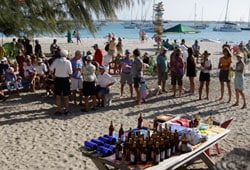
Bob Grieser| |At the Chat ‘n’ Chill’s post-regatta awards bash, they give prizes for everything, including Best Baking while under way.|
Yes, if you’re patient, there actually is a “regatta” at the George-Town Cruising Regatta. Actually, there’s a pair of races, the first a point-to-point contest of about 20 miles, starting and finishing in the main harbor after a circuit out in the ocean and around Stocking Island, and the second, a round-the-buoys in-harbor match. The former drew a couple of dozen monohulls and nine multihulls, the latter about half those numbers.
For the distance race, I scored a spot aboard a St. Francis 50 catamaran, Artemis. The boat’s owners, George and Jillian Godfrey, and their son, Greg, had originally sailed to the islands from their home in South Africa. After a career in banking, George started building the St. Francis line of cats and has since erected a multipurpose resort/sales office/bar/restaurant on an arresting parcel of land on Stocking Island, the scene of several regatta parties and gatherings.
Our crew for the race included Pam and Ollie from Let it Go, a Beneteau 41 (Ollie, I’d soon learn, has a serious problem keeping his pants around his waist, particularly when sailing close abeam another boat); Eric and Susan on Elysia, a Formosa 46; and Willis from Whistling Winds, a Contact 35. The actual racing, however, was but a sidelight to the overall proceedings. Other prizes, of equal merit, would be awarded for the Best Photograph, the Best Baking, and the Longest Edible Fish Caught, all of which had to be addressed while under way.
Soon after the start, four fishing lines were streaming astern. “If we run into a school of mahi, we’re in trouble,” said Eric. Moments later, Pam disappeared into the galley to whip up an incredible chocolate pecan pie-which turned out to be the winner. “This isn’t the Jenny Craig Race,” she said.
Meanwhile, as event chairman Stuart, in his soothing English tones, narrated the action on VHF Channel 78, the rest of the crew put Artemis through her paces. Skipper George was obviously a very solid and accomplished sailor, and he orchestrated a smart game plan from start to finish. In a fading breeze, Artemis glided past the finish line and the huge, raucous raft of inflatables partying off the race-committee boat, the first cat home.
Pam’s pie was an incredible success, but the two smallish barracuda in the fish hold were far less promising. “Maybe we could sew them together,” sighed Eric.
Two days later, for the In-Harbor Race, I joined Charlie and Terry on Voyager, their immaculate Jeanneau 43. It was, as they say, blowing the dogs off the chains, and things were definitely more chaotic than they’d been on Artemis. But Charlie had done his fair share of P.H.R.F. racing back in the day, and he managed to (mostly) keep his cool as we negotiated the two laps around the cans. Even though it was 10:30 a.m., the icy-cold beer was a welcome treat when all was said and done.
The dilemma when trying to write a story about the George-Town Cruising Regatta is perplexing: Where do you begin? Where do you end? I mean, all the sailors who’ve managed to extricate themselves from the so-called “real world” and make it all the way to the Bahamas have a great tale to tell. Nowhere was this more evident than at the post-racing regatta awards ceremony at the Chat ‘n’ Chill.
For instance, take Charlie and Lizz on Kaya, a Catana 401, who cleaned up in the multihull division. The “Charlie” who everyone on the beach knew was a laid-back dude having the time of his life. But Charlie Ogletree was also probably the best mariner in the harbor, a four-time Olympic cat sailor who’d earned a silver medal at the Athens Games.
Then there was Marc and Angie on a Manta 42, Side by Side, cruising with their children, Parker and Sabrina. The Johnson family was conspicuous in an unexpected way, for the one thing that seemed to be missing from the regatta: a big posse of cruising youngsters. “There were a whole lot of families who rolled back home after their savings tanked,” Marc said. “We’re on Year Three of a five-year plan, and we can’t see a reason to stop now.”
Then, at the epicenter of the eclectic gathering, was Kenneth Bowe, better known as K.B., the Bahamian-born proprietor of the Chat ‘n’ Chill and owner of the nine acres of unreal beach on which many of the regatta activities take place. “I figured out what the people wanted and what they needed,” he said. “I separated the wants from the needs and started with the needs. From there, the business has gone straight up.”
“Without K.B., there’d be no George-Town,” said Rockin’ Ron, who, now free of his radio, was hosting the awards gig.
“And without us,” whispered one cruiser, “he wouldn’t be a multi-millionaire.”
The Saturday-night awards ceremony segued into the Rockin’ Ron Dance Party, and before long, lots of cruisers were rollicking on the beach. But I decided to head for town to take in the Bahamian Music and Heritage Festival in “downtown” George-Town, at Regatta Park.
A group of cruisers in a band called Folks on Boats (previously known as “White Folks on Boats,” but since shortened for perhaps obvious political reasons) were playing, led by none other than the volleyball chairmen, Wayne and Isabel from Cassiopeia. They even sang an original tune called “Down and Out in George-Town”:
We packed it up and sailed away,
We’ll go to work another day.
I don’t want to LOOK at my 401(k)!
Just want to drink some rum,
get some sun,
have some fun,
down in George-Town.
Yeah, down in George-Town.
After their set, I was having a beer with the couple when the boisterous local Junkanoo band came rolling through. Suddenly, a guy with a big, green conch shell was beside us, blowing away. He handed it to Wayne, a natural musician, who gave it a hard look, blew a tentative note, realized he had it, and joined in step with the band, Isabel close behind.
The last I saw them, they were dancing away, jiving and swinging, two more fully grown cruising kids off to yet another George-Town sandbox.
CW editor at large Herb McCormick is now en route on a different camp activity, that of doubling Cape Horn. Catch up with him via his blog at CW’s website (www.cruisingworld.com).






